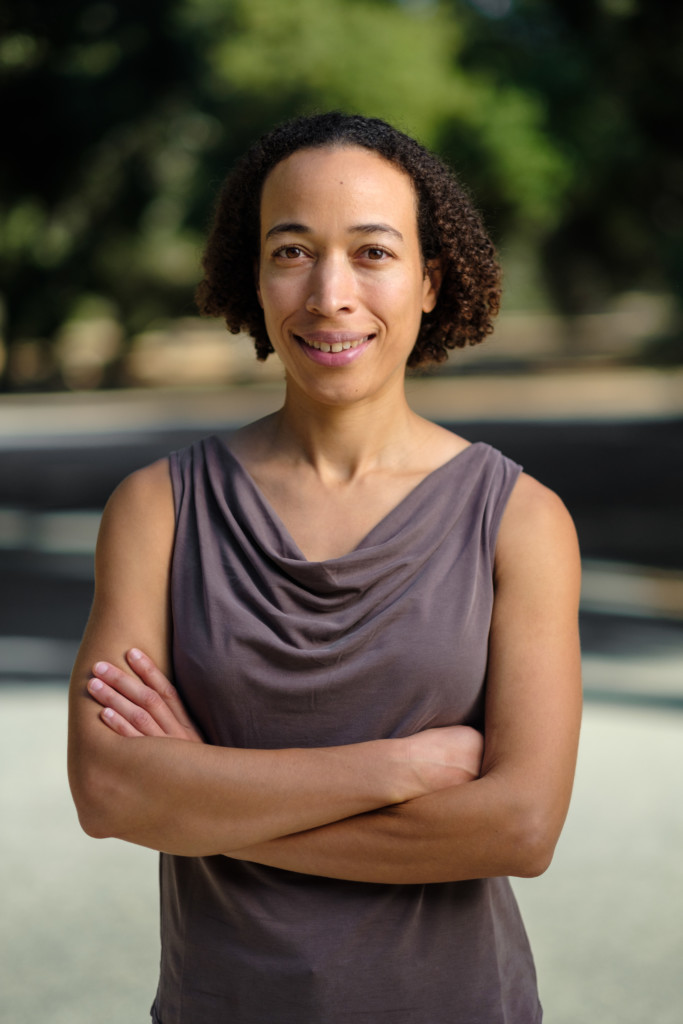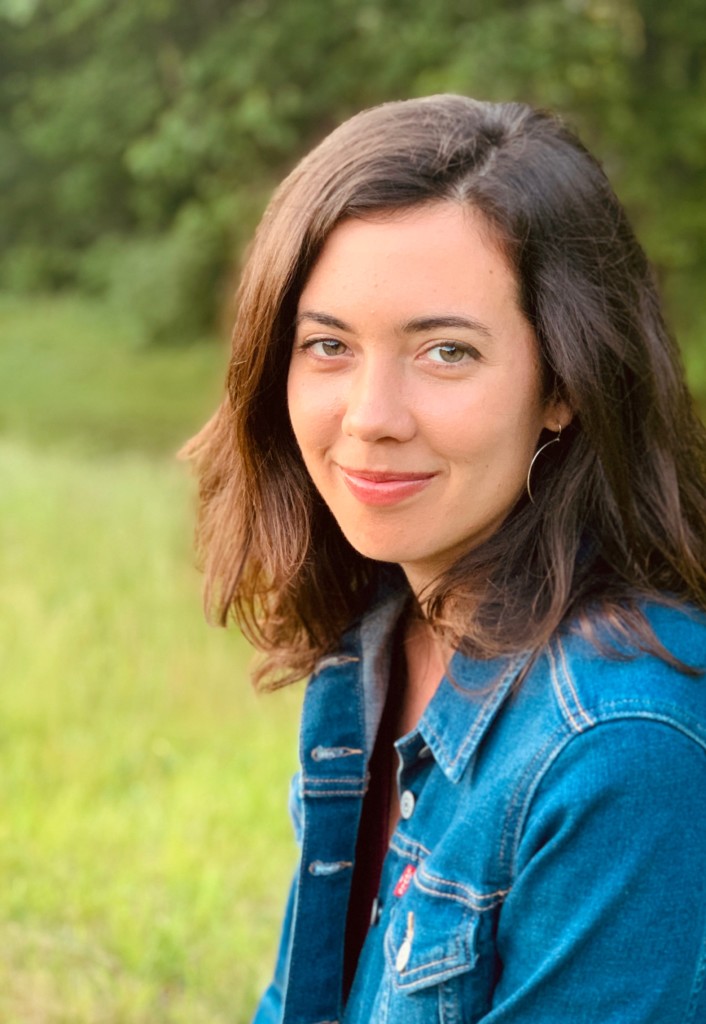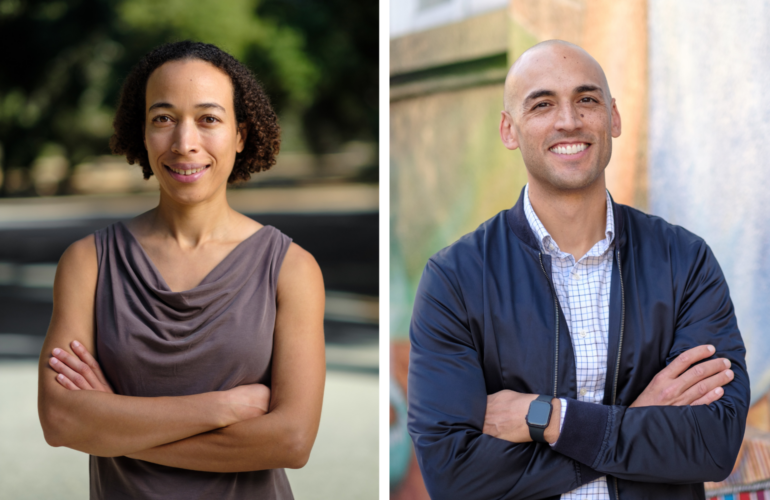There are many ways to define “genius,” but each October, Chicago’s MacArthur Foundation chooses around two dozen to honor. Among the diverse array of this year’s MacArthur fellows are a quantum physicist demystifying the habits of subatomic particles and a sociologist illuminating the way certain kinds of policing turn out to undermine public safety. In their own ways, both are helping us to see the world with more clarity and precision, and to reimagine how we might inhabit it. I got a chance to chat with Dr. Monika Schleier-Smith and Dr. Forrest Stuart and get a taste of their two quite different breeds of “genius.”
Schleier-Smith’s is more in keeping with the old-school, Einsteinian trope. In fact, Einstein came up halfway through our interview, in the context of topics like space-time curvature and reconciling the theory of gravity with the theory of quantum mechanics. When I asked Schleier-Smith if her work is reminiscent of the movie Interstellar, she laughed and said “that’s not totally off base,” which was a relief as it was the only mental image for “space-time curvature” I had to work with.

As it turns out, developing mental images for complex quantum phenomena has long been a priority of Schleier-Smith’s. Back in her days as a grad student at MIT, she was part of a group of physicists that choreographed a kind of “dance” meant to help them internalize the way these mind-bending phenomena operate. To this day, she is big on using creative illustrations and graphics to supplement her experiments.
The goal, she says, is to develop a kind of quantum “intuition.” Because quantum dynamics run so counter to our day-to-day, human-scale intuition, our imaginations are often too narrow to even conceive of certain questions, experiments, and possibilities in the quantum realm.
“When we think about quantum mechanics, and even sometimes when we’re trying to design some algorithm for a quantum computer, it’s often useful to have this intuition—pictures in our heads of waves and how they can interfere, constructively or destructively,” she explains. “Being able to have a picture in our head and not just equations is often really important for being able to predict the outcome of an experiment or come up with new ways of using quantum mechanics.”
The task of visualizing quantum phenomena is hard enough to begin with. But it’s made all the more difficult by a pesky catch-22 called the Heisenberg uncertainty principle, which makes observing atoms and subatomic particles elusive.
The idea, Schleier-Smith explains, is that: “You can’t know where something is and how fast it’s moving at the same time. This might seem counterintuitive: like you parked your car, and it’s not moving, and you know where it is. But when you get to very, very small particles like individual atoms, it turns out that if you want to know where the atom is you have to do something like bounce some light off it so it will hit your eye or a camera so you can see it—but that light itself will actually push the atom and change how fast it’s moving.”
In other words, you can’t see an atom without affecting it.
But when you spend so much of your mental life in the quantum realm, you’ve got to get good at managing the invisible and the counterintuitive. For Schleier-Smith, one way has been to create illustrations of the uncertainty itself.
“We often draw pictures for ourselves, where we have two axes, one that represents position and one that represents velocity, and we think of the system as some sort of a fuzzy blob on this coordinate plot,” she tells me. “And when we entangle the system, we can actually sort of squeeze that fuzzy blob so that it gets narrow in one direction at the expense of becoming broad at the other. That’s an example of a time when we have pictures in our mind of quantum uncertainty that help us actually think about how you would design a quantum state to minimize the uncertainty.”

One of her final and most brilliant insights was that the pandemic and the prevalence of remote communication have actually made an important quantum phenomenon called “entanglement” a little more intuitive. Entanglement is all about particles interacting at a distance; information is stored not in particular particles but rather in the correlations between them.
“The reason that this phenomenon is so counterintuitive is that it defies our intuition that physics is local,” Schleier-Smith explains. “You can have information that’s not in just one place—it’s distributed in a non-local way—and that’s weird to us is because the way we interact with the world is local: interactions happen through gravitational forces between particles that decay with distance. If they’re far apart, they don’t interact, and so you wouldn’t think there should be information shared between them. But in the “classical world”—by which she means the world that all us non-quantum-physicists spend our time in—“we’ve learned to overcome that. In the same way that I’m able to just pick up the phone and talk to you all the way from California, as opposed to knocking on my next-door neighbor’s door, we can all have these interactions that are very non-local, and that changes the way that information spreads. What we’re doing in the lab is the equivalent for quantum systems. You have atoms basically using light to convey information between them and talk to each other in a way that’s non-local and in a way that can more efficiently spread information…we can use a laser beam to program the way these atoms talk to each other in the same way that I can dial in a number on my cell phone.”
Schleier-Smith’s quantum intuition seems to be pretty sharp, because it’s enabled her to design creative experiments that have been adopted in labs around the world and unlocked new kinds of quantum understanding—particularly surrounding entanglement. In addition to the MacArthur “genius” grant, she was awarded the Presidential Early Career Award for Scientists and Engineers, which is the highest honor granted by the United States government to scientists early in their research careers. An alum of Harvard and MIT, she now teaches at Stanford.
Also at Stanford, and also engaged in an ambitious project of subverting conventional intuition is fellow “genius’ Forrest Stuart. While Stuart spends his time studying what Schleier-Smith refers to as “the classical world,” he too is interested in shedding light on phenomena that have long been misunderstood: namely, policing and urban violence.
Stuart grew up in San Bernardino, California, which at the time was one of the poorest cities in the country and had the highest per capita homicide rate.
“In San Bernardino, I experienced my fair share of urban violence and poverty,” he explains. “Men in the last three generations of my family have all spent time incarcerated, so these were all things that I was very familiar with.”
But when he left for college at U.C. Santa Cruz, the way he understood these dynamics was completely upended.
“Like a lot of folks living in places like San Bernardino, I’d had quite a neoliberal, individualized way of looking at social problems, like: bad people do bad things. I wasn’t thinking very structurally. But, when I arrived in Santa Cruz, I suddenly was inundated with these theories and discussions of structural inequality,” he says. Armed with a deeper understanding of the economic and criminal justice systems, he came to realize, “No, it’s not my neighbor’s fault back in San Bernardino; there are these larger structures that are not only disadvantaging us, but extracting value off of our backs and quite intentionally making my hometown as bad as it is.”

He’s made it his life’s work to help others come to this same realization—and ultimately to change some of the policies most at fault. As an ethnographer, his research endeavors to paint a more accurate picture of the forces shaping urban poverty than the one policymakers tend to work from. He spent five years talking to homeless people in L.A. about how they interface with police, and later, 18 months embedded in a gang in Chicago.
“A lot of my work is dedicated to studying policing policies that on their face maybe seemed like a good idea, maybe seemed like we were improving public safety, but when we actually get down into the mundane realities that people face every single day in the urban poor communities where that policing is launched, what we see is that they actually often decrease public safety.”
For years, this was a fairly radical, counterintuitive notion to promote. But during the summer of 2020—just months before he was named a ‘genius’—that suddenly changed.
“I’d spent most of my career just trying to convince the public and policymakers that policing was harmful. That was the goal; that was the incredible uphill battle to climb: just to show how much damage policing causes to these marginalized communities of color,” Stuart explains. But as Black Lives Matter protests arose across the nation, “it was almost like overnight, people accepted that and moved forward into a space of like, ‘okay, we get it, we believe you, what do we do now?’ And I think for me and for a lot of academics operating in this space, it took us off-guard, and has a lot of us kind of scrambling to very quickly and systematically try to articulate the kinds of prescriptive recommendations that come out of our work. We spent so much time and energy doing the diagnosis and the description that it didn’t leave a whole lot of room for prescription.”
But as this conversation has transformed, Stuart has seized the moment. He’s thrown his weight behind a program called L.E.A.D. (Law Enforcement Assisted Diversion), which was designed by a former MacArthur fellow, Lisa Daugaard. Pioneered in Seattle, it has now been adopted in 77 jurisdictions and been shown to have tremendous positive impacts on both recidivism rates and overall cost to taxpayers.
Through years of fieldwork, researchers like Stuart have identified precisely what goes wrong in traditional policing models which they have mobilized to defend this new approach. “The single most efficient way that we know of to reduce the harm that police cause people—including killing people—is to shift addressing behavioral health issues out of police hands,” he explains succinctly. “There are studies out there that show half the people killed by police officers have a mental health disorder or disability, so we know that these kinds of interactions go bad really quickly. We also know that police officers are not really equipped to deal with these kinds of problems.”
To articulate how LEAD handles would-be-criminals differently, Stuart offers a lucid example:
“Say there’s someone who has a mental illness and is bothering customers in a downtown business district: taking his shirt off, a dirty rug pulled over himself, maybe he’s banging on windows, maybe he’s defecating in the street, maybe he’s scaring customers. You can call a cop and the cop will move him along; maybe the cop will arrest him. But then that guy is back out—he’s back on that corner, either minutes later or hours later or maybe a day later. So officers are able to maybe mitigate the immediate acute situation, maybe, if they don’t end up escalating it, but there’s no long-term improvement—for the business, for the pedestrians, for this person who’s clearly in crisis. And so what this program LEAD does is it has all of these innovative ways of rerouting the 911-call process so rather than folks calling 911, they contact a case manager who is a part of this program who can come and do this intensive and long-term outreach with this person and get them into harm reduction services. These are things like supportive housing, getting disability services kicked in, getting mental health treatment, getting them on opioid alternatives—all the kinds of wraparound services that vulnerable folks, folks dealing with behavioral health issues, need so much. And so the program essentially takes this person and the regulation of their behavior out of the hands of people with guns and handcuffs and puts it in the hands of people who actually have the behavioral health services that this person needs. And the success has been amazing. $6000 per year reduction jail costs, more likely to get employed, etc.—every single metric that we have. That program was built on the backs of researchers like me pointing out that 1) policing causes harms in these situations, and 2) there are all these services out there that prove to be far better for someone than handcuffs and a jail cell.”
But if we’ve known all this for years—LEAD was first introduced in 2011—why only now is there so much appetite for transformation? Certainly, the summer’s nationwide protests earned the problem unprecedented attention.
But just like Schleier-Smith, Stuart also credits the pandemic with helping people imagine a new paradigm. He says:
“I think COVID made people across the class, racial and ethnic spectrums feel abandoned by the folks who they thought were taking care of them and could be trusted… I think people felt enough betrayal, and enough distrust toward policymakers and the state more generally that they were suddenly in this cognitive space where they could understand that the state had neglected and maybe brutalized communities, that this wasn’t just people crying wolf.”
Now that current policing practices are finally being reconsidered, Stuart plans to shift his focus toward a still-overlooked area of urban poverty research: women. He feels that most urban violence and poverty scholarship focuses too narrowly on young men: “we imagine young men as being both at the center of urban violence and also the most immediate victims. They are shot at, they are shooting, and we end the analysis there.” But during his work in Chicago, his perspective broadened. He lost some people close to him, and witnessed the aftermath firsthand: the funerals, the vigils, the police investigations, the ripple effects. Through these experiences, he says:
“It just became so clear to me that if we are going to paint a more accurate picture of the ways that violence saturates the everyday lives and concerns of communities, if we’re going to understand how this incredible state neglect of these communities really seeps into daily life, then we have to expand our perspective and our analyses and not solely focus it on young men—because women, moms, girlfriends, sisters, they bear so much of this weight. They’re the ones keeping families and communities whole in the wake of these tragedies. They are the emotional rock. They’re the ones who are supporting folks when guys get locked up over this stuff, they’re the ones who are putting money on commissary, they’re the ones fielding phone calls. I was just blown away by the incredible invisible labor that women were doing, not just on behalf of the young men in their lives but on behalf of their communities who are hyper-traumatized by the violence that is going on. And they’re doing all this amid horrendous treatment by all the institutions that we would assume are there to support and to help them… There’s this secondary stigma, so they not only have to deal with having lost their sons; they also have to deal with the demonization that all these social institutions that are supposed to help them through that are casting on them because they somehow managed to raise this son who turned out bad. They blame the predicament of her son on her, it’s almost as though they treat her like she was the reason he was killed.”
He wants to document these women’s experiences in order to build a case for transforming not only the way violence is policed, but the way its aftermath is handled: by detectives, hospital workers, prosecutors, and others involved. He hopes this work will help us “begin to build the kinds of institutions and programs and communities that, rather than increase the trauma of women’s lives in the wake of these events, wrap our arms around them and allow them to mourn and grieve in ways that people in more advantaged communities are allowed to grieve and are allowed to mourn. Because I think this is a really understudied form of inequality: that some communities are allowed to have certain emotions validated while other communities are not.”
The passion in Stuart’s voice was palpable, as was his energy as he shared his innovative ideas for how he plans to conduct this research, including inviting community-members to collaborate as research assistants rather than just be subjects, and experimenting with photojournalism. “This is a super ambitious and outside-of-the-box design of a research project, particularly for a sociologist, and so it’s a hard one to get funded,” he says. “So this MacArthur grant comes at just the perfect time.”
At $625,000, the grant is one of the few that come no-strings-attached; it is meant to give recipients license to take risks and push the envelope in the next stages of their careers.
Being the arbiters of genius is quite a hefty task, with all kinds of room for bias and subjectivity—but if the other 19 fellows are anything like these two, it seems clear this year’s team at MacArthur Foundation got it just about right.
More From Better:
- Mariano’s to Offer Rapid Covid-19 Antibody Testing
- 2020 Holiday Gift Guide: Gifts for Everyone on Your List
- Home For The Holidays with Yūgen Executive Chef Mari Katsumura

Eve Driver is a freelance writer based in Boston. A recent graduate of Harvard College, she writes on climate, technology, and travel and is also working on her first book.

